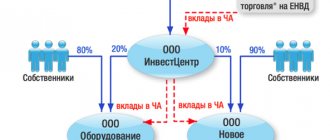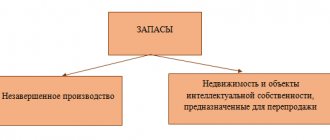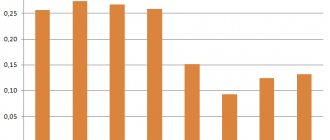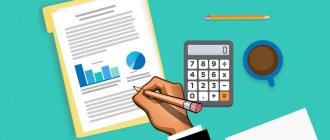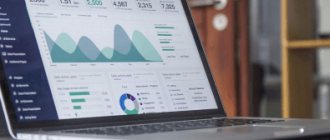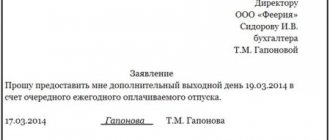Inventories are part of an organization’s tangible property intended for the production of final products.
By showing them on the balance sheet, the company reflects information about resources at the end of the reporting year. Raw materials and supplies - which were not used in the production process, for them, in line 1210 of the balance sheet, information about the balances of funds in the debit and credit of accounts is formed. The composition of raw materials may vary depending on the products manufactured by the enterprise.
For example, if we are talking about winemaking, it could be grapes or another product involved in the preparation process.
Line 1210 of the balance sheet “Inventories”
In line 1210 enter data on the total value of the company's inventories listed as of December 31, 2015. A breakdown of the data in line 1210 by groups and types of inventories listed in the organization is given in Section 4 of the Explanations to the Balance Sheet and the Income Statement. So, for example, the data could be given here:
- on the cost of raw materials and materials not written off for production, recorded in the debit of accounts 10 “Materials”, 15 “Procurement and acquisition of material assets”, 16 “Deviation in the cost of material assets”;
- on the cost of goods intended for resale, recorded in the debit of account 41 “Goods”;
- on the cost of finished products, recorded in the debit of account 43 “Finished products”;
- on the cost of finished products and goods shipped to customers, recorded as the debit of account 45 “Goods shipped”;
- on the amount of costs in work in progress recorded in accounts 20 “Main production”, 23 “Auxiliary production”, 29 “Service production and facilities”;
- on the amount of sales costs that were not written off to the accounts for accounting for sales revenue, recorded in the debit of account 44 “Costs of circulation”;
- on the amount of unwritten off deferred expenses recorded in the debit of account 97 “Deferred expenses”.
Raw materials
Raw materials include material assets that are the basis for the manufacture of a particular product, are included in its composition or are necessary components in its manufacture. In addition, raw materials are considered to be resources that are fully used in the process of the company's activities. According to the Chart of Accounts, these types of assets also include: purchased semi-finished products; finished components; fuel (oil, kerosene, gasoline, etc.) and lubricants; container; spare parts for repair of fixed assets; production waste (stumps, cuttings, shavings, etc.); inventory, tools and household supplies that are not included in fixed assets; special clothes.
Accounting for such property is regulated by PBU 5/01. According to paragraph 5 of the document, raw materials and materials are taken into account at actual cost.
Line 1210 includes the initial cost of raw materials and materials not written off for production as of December 31, 2015. It is recorded in the debit of account 10 “Materials”. This balance line shows the debit balance of this account as of the mentioned date.
Materials can be reflected both at actual cost and at accounting (planned) prices. When using the second option, their cost is formed using accounts 15 “Procurement and acquisition of material assets” and 16 “Deviation in the cost of material assets.” In this situation, line 1210 of the balance sheet indicates the debit balance of account 10 (accounting price of materials), 15 (cost of materials in transit) and 16 (deviations). If the balance of account 16 is credit, then it reduces the cost of materials at which they are reflected in the balance sheet.
The company has the right to create a reserve for depreciation of the cost of raw materials and materials. Its amount is taken into account in the credit of account 14 “Reserves for reduction in the value of material assets.” If there is a reserve, its amount reduces the cost of materials at which they are reflected in the balance sheet.
Formation of the actual cost of materials...
The actual cost of materials is based on all costs associated with the acquisition of this property (excluding VAT, if the company accepts it for deduction). According to paragraph 6 of PBU 5/01, such costs include, in particular:
- amounts paid to the materials supplier;
- expenses for information and consulting services related to the purchase of materials;
- customs duties accrued when importing materials into Russia;
- expenses for the services of the intermediary through whom the materials were purchased;
- costs for the procurement and delivery of materials to the place of their use;
- materials insurance costs;
- expenses for maintaining the company's procurement and warehouse division;
- interest costs on commercial loans provided by material suppliers;
- expenses for paying interest on bank loans received for the purchase of materials and accrued until the moment of their receipt;
- expenses for bringing materials to a state suitable for use for the intended purposes (for example, for their additional processing, sorting, packaging, improving technical characteristics);
- general business expenses directly related to the purchase of materials.
Like any other property, materials can be obtained in several ways. For example, purchased for a fee, manufactured by the company itself, received as a contribution to the authorized capital or free of charge, acquired as part of commodity exchange (barter) transactions, capitalized as a result of disassembly and dismantling of fixed assets. Depending on the method of acquiring materials, the company forms their initial cost.
Input VAT
Line 1220 “VAT on purchased assets”
Line 1220 reflects the amount of tax that the company will be able to deduct in the future. The remaining value (debit balance) for account 19 is transferred to this balance line.
To exercise the right to deduction, a number of conditions must be simultaneously met:
- the acquired assets are intended for the type of activity that is subject to VAT;
- the cost of acquired assets is reflected in accounting;
- there is a correctly issued invoice from the supplier.
For many organizations, account 19 is reset to zero at the end of the year, and in this case a dash is added to line 1220 of the balance sheet. The balance on account 19 may arise in such cases (all of them follow from the text of Articles 171 and 172 of the Tax Code of the Russian Federation):
- when exporting raw materials (the delay in accepting VAT for deduction is due to the fact that it is necessary to go through the procedure of confirming the fact of export);
- if the acquired assets are used by a company with a long production cycle (VAT is deductible only after the finished product is shipped to the buyer);
- if the supplier did not provide an invoice or the invoice was issued with significant violations;
- when the taxpayer decides to deduct it at a later period (before the expiration of 3 years from the date of registration of the acquired property).
NOTE! For organizations with large balances on account 19, it is better to detail the value of line 1220. This right is provided for in clause 6 of PBU 4/99 “Accounting statements of an organization” (approved by order of the Ministry of Finance of the Russian Federation dated July 6, 1999 No. 43n). This can be done by adding lines 12201, 12202, etc. Detailing is possible in the context of operations (purchase) by fixed assets, inventories, intangible assets and others.
Standardized expenses
A debit balance on account 19 can also be formed when paying expenses, which are normalized when calculating income tax. Thus, there are expenses that cannot be fully taken into account in the tax base when calculating income tax.
Read about what expenses are regulated and what the limits for rationing are in the material “Standards provided for by the Tax Code of the Russian Federation” .
Hand in hand, taking into account standardized expenses, comes the problem of deducting value added tax. That is, if these expenses are normalized, then the right to deduct VAT on them is also curtailed.
In this case, usually the final value of the indicator for calculating the standard becomes known only at the end of the year, and the expenses themselves can be collected throughout the year, and the accountant has the obligation to quarterly adjust the VAT amount as the base from which the standard is determined increases.
At the end of the year, some amounts of undeductible VAT may accumulate. Their last day of the year should be written off as other expenses, since tax amounts exceeding the amount corresponding to the calculated value of the standard will no longer be accepted for deduction.
What reserves are included in the balance sheet?
To begin with, it is worth saying that the resources themselves for the production of products are only part of what is recognized as reserves, and what line 1210 of the balance sheet consists of. They are divided into several categories:
- Materials and raw materials used for the manufacture of goods or work.
- Financial costs for materials and raw materials. Materials for production also include fuel, repair tools, clothing and waste generated at the enterprise.
- Money for employee salaries, as well as social benefits.
- The number of products that are not yet completed in production.
- Finished products for sale, as well as services, works, animals. Before shipment they undergo mandatory quality checks.
- Expenses for new production equipment and its modernization.
- Depreciation expenses.
- Cost of gross output.
- Costs for customs duties.
- Taxes belonging to the non-refundable category.
- Funds paid by an enterprise to the seller of products for his services.
- Consulting services if the company's activities related to the sale and purchase of inventories.
- Transportation of goods, storage services in warehouses.
- Costs related to advertising.
The balance sheet reflects only general information about all these categories, without decoding. And all purchases, payments and sales of shipped goods must have documentary evidence. Inventory analysis is needed in order to optimize them, because a shortage is just as bad as an excess. The consequence of the first scenario is a delay in the production of goods, and the second is the withdrawal of money from the company’s turnover, which will be spent on the purchase of goods that were not included in production.
Advances listed
Line 1230 “Accounts receivable”
This line reflects the full amounts of buyer (debtor) debts remaining at the end of the year, including VAT. Here we summarize the data corresponding to the balances (debit) of accounts 60, 62, 76, as well as the total values for the debit of the “Settlements with ...” accounts: 68, 69, 70, 71, 73 and 75, reduced by the balance (credit) of the account 63.
Starting from 2011, organizations are required to form a reserve for doubtful debts (account 63, the balance of which is subtracted from the value accumulated in line 1230 of the balance sheet). This includes those debts of debtors for which they no longer hope to receive payment.
The organization independently determines such debts by assessing the likelihood of full or partial non-repayment (letter of the Ministry of Finance of Russia dated January 27, 2012 No. 07-02-18/01).
According to the explanations of the Ministry of Finance of Russia, when the buyer transfers an advance to the supplier, receivables are reflected in the balance sheet minus VAT, subject to deduction or accepted for deduction (attachment to the letter of the Ministry of Finance of Russia dated 01/09/2013 No. 07-02-18/01).
This means that in line 1230, in addition to existing accounts receivable with VAT, the amount of advances transferred to suppliers against a future transaction (shipment of goods, provision of work (services), transfer of property rights) is reflected minus VAT.
Balance sheet
The balance sheet is one of the basic forms of accounting for commercial enterprises, thanks to which you can obtain information about:
- Property status of the company.
- Her financial stability.
- Liquidity.
- Solvency, etc.
The balance sheet consists of two parts - assets and liabilities, equal to each other in amounts. Inventories and expenses in the balance sheet are indicated in line 1210, and relate to the Assets part, subsection “Current assets”. There you can also find information about VAT on purchased assets, financial investments and receivables. But here it is worth recalling that all inventories are reflected in account 002, which is classified as off-balance sheet.
Line "Inventories" in the balance sheet
Now the balance sheet for accounting has a new form to fill out, which, according to accountants, has become simpler than the previous one. Now there is no need to detail the data, highlighting only the main thing. But they need to be filled out correctly, and for this you need to know the decoding of line 1210 of the balance sheet. Thus, to reflect information, the following manipulations are carried out with debit and credit account balances:
- 10, containing data on raw materials and supplies in the balance line, is added to 11 - it contains information about fattening animals. This category includes not only artiodactyls, but also birds, rabbits, bees, etc.
- The credit balance 14 is subtracted from the addition result.
- Add 15 – purchase of material assets.
- 16 is either added or subtracted, depending on the circumstances. Data on 15 and 16 should be entered only for stocks of raw materials and materials.
- The balances from 20, 21, 23, as well as 28 and 29 accounts are added to the result obtained.
- Then you need to find the balance of 41 and also add it.
- The credit balance of account 42 is deducted.
- The last steps are to add balance 43 - “Finished products”, as well as 44, 45 and 97. The latter includes only those expenses that were written off within one year.
After the calculations, an assessment is made. There are several methods available to an accountant to carry it out, for example:
- Calculate the average commodity cost.
- Accounting at cost of all production goods, etc.
The most commonly used method is one associated with recording the time of purchase of goods, since it is recognized as more convenient than others.
Conclusions about what a change in indicator means
If the indicator is higher than normal
Not standardized
If the indicator is below normal
Not standardized
If the indicator increases
A positive factor if revenue and profit growth occurs faster. Negative if it's the other way around.
If the indicator decreases
A positive factor if there is an increase in revenue and profit. Negative if revenue and profit fall faster than inventory reduction.
Notes
The indicator in the article is considered from the point of view not of accounting, but of financial management. Therefore, sometimes it can be defined differently. It depends on the author's approach.
In most cases, universities accept any definition option, since deviations according to different approaches and formulas are usually within a maximum of a few percent.
The indicator is considered in the main free online financial analysis service and some other services
If you need conclusions after calculating the indicators, please look at this article: conclusions from financial analysis
If you see any inaccuracy or typo, please also indicate this in the comment. I try to write as simply as possible, but if something is still not clear, questions and clarifications can be written in the comments to any article on the site.
Best regards, Alexander Krylov,
The financial analysis:
- II. CURRENT ASSETS Current assets are property used in the activities of an enterprise for less than a year or used in one production cycle, which also does not exceed one year. Its entire cost...
- I. NON-CURRENT ASSETS Non-current assets are property used in the activities of an enterprise for more than a year. Its value is transferred in parts to the cost of finished products. A sign of assets is the ability to generate income for the organization.…
- III. CAPITAL AND RESERVES Section III Capital and Reserves is the third section of the balance sheet. But what is more important is the first section of financial sources, that is, the liability side of the balance sheet. By this he...
- IV. LONG-TERM LIABILITIES Section IV. Long-term liabilities are the fourth section of the balance sheet. At the same time, it is also the second section of the liability side of the balance sheet, which shows the sources of financing for the property. AND…
- Balance sheet asset A balance sheet asset is a part of the balance sheet containing data on the assets of the enterprise, that is, on its property. The balance sheet asset reflects property, property rights and cash...
- V. CURRENT LIABILITIES Section V. Current liabilities is the fifth section of the balance sheet. At the same time, it is also the third section of the liability side of the balance sheet, which shows the sources of financing for the property. AND…
- Absolute economic indicators of an enterprise's activity Absolute economic indicators of an enterprise's activity are indicators that allow us to judge several things: The size of the enterprise and the scale of its activities The level of income and expenses...
- Key performance indicators of an enterprise Key performance indicators of an enterprise are indicators that allow us to judge several things: The size of the enterprise and the scale of its activities The level of income and expenses About ...
- Balance sheet liability The balance sheet liability is the second part of the balance sheet. It contains a list of those financial resources that were used to acquire property, that is, assets that...
- Financial analysis of budgetary organizations online for free: state (municipal) institutions and... This is a new free analysis service taking into account changes in reporting for 2021 and beyond. For earlier reporting, the analysis is here: analysis of data from a budgetary organization...
Notes on future expenses
In order for the documents to reflect costs in subsequent periods, they must be described according to all the rules. This can be done on the balance sheet line, but this accounting procedure must be noted in the company’s accounting policy. For example, account 97 will allow you to create additional subaccounts in line 1210, which will contain information about expenses in the following purchasing periods.
All resources used for production are accounted for in the debit balance of account 10. For this, the initial price of those goods that will be written off before the end of the next reporting period is used. To simplify this process, accounts 15 and 16 are usually taken. The first reflects information about acquired and procured assets, the cost of material assets, the second - about deviations in their cost. This allows you to describe materials and raw materials, as well as reflect their accounting price in as much detail as possible.
Information about manufactured products is included in line 1210.
Here it is important to mention account 14. It will come in handy if production decides to create a reserve fund, with the help of which it will be possible to depreciate the total amount of inventory. Depreciation here is a decrease in the value of inventories.
So, in account 14, raw materials and supplies are recorded, minus the reserve for their depreciation. Subsequently, their cost should be several times lower than the initial one by the date of the report. To determine whether these conditions are met, an impairment test is performed:
- It is determined which assets are involved in testing.
- The value of the asset to be recovered is calculated.
- Impairment losses are determined.
- The loss is recognized as a gain or loss from impairment over a specified period of time.
- An analysis of the resulting calculations is being prepared.
- All data is documented.
- Reporting is completed.
Thanks to this process, it is possible to reduce the price of consumed resources several times, thereby stopping overconsumption in further periods.
The company's reserves noted in the documentation allow us to assess its material security. The availability of resources must be maintained at a certain level so that there is no shortage or overexpenditure in the reserve. The balance sheet stability of an organization's inventory indicates its competent management policy and good marketing, since the income of the entire enterprise depends on the speed of inventory turnover.
Advances received
Line 1520 “Debt to creditors”
The line “Debt to creditors” (balance sheet liability) summarizes the balances (credit) on the following accounts: 60, 62, 68, 69, 70, 71, 73, 75 and 76, including VAT. These are all the debts of the enterprise that it is obliged to repay within a year, or during the production cycle if it exceeds a calendar year.
IMPORTANT! The amounts of debts to the budget must be verified with the fiscal authorities. It is strictly prohibited to arbitrarily calculate unsettled debts to the budget (clause 74 of the PBU on accounting and accounting in the Russian Federation, approved by order of the Ministry of Finance of the Russian Federation dated July 29, 1998 No. 34n).
When forming line 1520 of the balance sheet, you should take into account a certain nuance with the reflection of advances received. Here there is a situation similar to that of the advances listed. The Russian Ministry of Finance also recommends that advances received be reflected in the balance sheet minus VAT (attachment to the letter of the Russian Ministry of Finance dated January 9, 2013 No. 07-02-18/01).
So on line 1520 you should include:
- accounts payable including VAT,
- advances received minus VAT.
VAT is reflected in the balance sheet as follows:
- in the asset - in two lines (1220 and 1230),
- in the passive - in one line (1520).
The Russian Ministry of Finance advises including in lines 1230 and 1520 receivables and payables for advances minus VAT. Note that the taxpayer has the right to act differently and not deduct the amount of tax from the debt. However, in this case you need to be prepared to argue your position.
Methods for accepting inventories for accounting during inflows and settlements with suppliers
These operations are carried out on the basis of concluded contracts. During shipment, supply companies draw up settlement papers and hand them over to the customer. In addition, a road invoice is issued. All documents are transferred to the marketing department. Its employees check them, register them, accept them and give their approval for the transfer of funds. Afterwards, each of them is assigned an individual number, and then they are sent to the accounting department for payment. Paperwork related to logistics costs is transferred to the forwarder.
For operations, a special account “Settlements with suppliers and contractors” is used.
Primary documents
The papers that are used when accounting for inventories in the warehouse and in the accounting department are standard.
When assets come into the possession of an enterprise, a receipt order in form M-4 is used to register them, as well as an acceptance certificate (in form M-7). The first is upon arrival from the supplier. The responsibilities of the warehouse manager include checking whether the actual quantity corresponds to the officially declared quantity. The second is issued if discrepancies are detected, as well as when working with uninvoiced deliveries. This document is drawn up by a special commission, and a representative of the sending company or an uninterested party must be present. The paper is prepared in two samples. The first one is sent to the accounting department and is used as a reason for depositing the amount into the accounts. The other goes to marketers. Based on this, complaints will be made to the supplier.
If materials were transported by car, the primary documentation is the consignment note. It is issued in 4 copies. The first of them is used to write off assets from the sending company. The second is used so that the recipient can capitalize them. Another one is needed for settlements with the carrier company. The latter serves as an appendix to the route sheet.
There are a number of regulations according to which expenses for production needs are recorded. Among them:
- Limit collection card - issued by the marketing department, used for systematic deliveries.
- Request for release of materials - given in the case of a one-time operation.
- Invoice. When transferring resources to third party organizations, it is issued on the basis of concluded contracts.
It is worth noting that companies have the right to develop their own forms and reduce their number by combining them.
Do you want to implement Warehouse 15? Get all the necessary information from a specialist.
Thank you!
Thank you, your application has been accepted!
Methods for accounting for inventories during procurement
There are two main ways this operation can be performed. The first is to generate the actual cost in the “Materials” account. It is advisable to use it only in certain cases. For example, when a company has a small volume of supplies over a period of time. If the company has a small range of assets or the accounting department receives all the information at a time. The table provides an example of such calculations.
| № | Contents of operation | Debit | Credit |
| 1 | The price of goods and materials was calculated using the invoice and invoice | 10 | 60 |
| 2 | Accounting for value added tax | 19 | 79 |
| 3 | Logistics costs | 10 | 76 |
| 4 | Remuneration for intermediary companies | 10 | 76 |
The second is to use separate accounts. For example, “Accounts payable”.
Documenting
As stated above, there are several regulations that can be used to capture motion.
The receipt of assets at the company's warehouse is formalized using a receipt order or a materials acceptance certificate. The decision to use one of these papers is made after carefully calculating the amount of resources and comparing it with that specified in the contract. If the results match, the first option is applied.
The consignment note acts as the primary regulatory document for accounting for inventories if transportation was carried out by cars. Internal movement is specified by the organization's employees in the requirement.
There are limit-fence cards that are used to fix costs.
